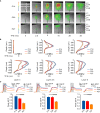Developmental regulation of spatio-temporal patterns of cortical circuit activation
- PMID: 23316135
- PMCID: PMC3539829
- DOI: 10.3389/fncel.2012.00065
Developmental regulation of spatio-temporal patterns of cortical circuit activation
Abstract
Neural circuits are refined in an experience-dependent manner during early postnatal development. How development modulates the spatio-temporal propagation of activity through cortical circuits is poorly understood. Here we use voltage-sensitive dye imaging (VSD) to show that there are significant changes in the spatio-temporal patterns of intracortical signals in primary visual cortex (V1) from postnatal day 13 (P13), eye opening, to P28, the peak of the critical period for rodent visual cortical plasticity. Upon direct stimulation of layer 4 (L4), activity spreads to L2/3 and to L5 at all ages. However, while from eye opening to the peak of the critical period, the amplitude and persistence of the voltage signal decrease, peak activation is reached more quickly and the interlaminar gain increases with age. The lateral spread of activation within layers remains unchanged throughout the time window under analysis. These developmental changes in spatio-temporal patterns of intracortical circuit activation are mediated by differences in the contributions of excitatory and inhibitory synaptic components. Our results demonstrate that after eye opening the circuit in V1 is refined through a progression of changes that shape the spatio-temporal patterns of circuit activation. Signals become more efficiently propagated across layers through developmentally regulated changes in interlaminar gain.
Keywords: AMPA; GABA; NMDA; microcircuitry; postnatal development; signal propagation; synaptic plasticity; visual cortex.
Figures







Similar articles
-
Visual experience modulates spatio-temporal dynamics of circuit activation.Front Cell Neurosci. 2011 Jun 28;5:12. doi: 10.3389/fncel.2011.00012. eCollection 2011. Front Cell Neurosci. 2011. PMID: 21743804 Free PMC article.
-
Laminar circuit organization and response modulation in mouse visual cortex.Front Neural Circuits. 2012 Oct 5;6:70. doi: 10.3389/fncir.2012.00070. eCollection 2012. Front Neural Circuits. 2012. PMID: 23060751 Free PMC article.
-
Transient Coupling between Infragranular and Subplate Layers to Layer 1 Neurons Before Ear Opening and throughout the Critical Period Depends on Peripheral Activity.J Neurosci. 2022 Mar 2;42(9):1702-1718. doi: 10.1523/JNEUROSCI.2505-20.2021. Epub 2022 Jan 14. J Neurosci. 2022. PMID: 35031575 Free PMC article.
-
The age of plasticity: developmental regulation of synaptic plasticity in neocortical microcircuits.Prog Brain Res. 2008;169:211-23. doi: 10.1016/S0079-6123(07)00012-X. Prog Brain Res. 2008. PMID: 18394476 Review.
-
Voltage Imaging in the Study of Hippocampal Circuit Function and Plasticity.Adv Exp Med Biol. 2015;859:197-211. doi: 10.1007/978-3-319-17641-3_8. Adv Exp Med Biol. 2015. PMID: 26238054 Review.
Cited by
-
MeCP2 regulates the timing of critical period plasticity that shapes functional connectivity in primary visual cortex.Proc Natl Acad Sci U S A. 2015 Aug 25;112(34):E4782-91. doi: 10.1073/pnas.1506499112. Epub 2015 Aug 10. Proc Natl Acad Sci U S A. 2015. PMID: 26261347 Free PMC article.
-
Cortical amplification models of experience-dependent development of selective columns and response sparsification.J Neurophysiol. 2017 Aug 1;118(2):874-893. doi: 10.1152/jn.00177.2017. Epub 2017 May 17. J Neurophysiol. 2017. PMID: 28515285 Free PMC article.
-
GABAergic synapses: their plasticity and role in sensory cortex.Front Cell Neurosci. 2014 Mar 26;8:91. doi: 10.3389/fncel.2014.00091. eCollection 2014. Front Cell Neurosci. 2014. PMID: 24723851 Free PMC article. Review.
-
Long-Term Spatiotemporal Reconfiguration of Neuronal Activity Revealed by Voltage-Sensitive Dye Imaging in the Cerebellar Granular Layer.Neural Plast. 2015;2015:284986. doi: 10.1155/2015/284986. Epub 2015 Jul 29. Neural Plast. 2015. PMID: 26294979 Free PMC article.
-
Emergence of Functional Specificity in Balanced Networks with Synaptic Plasticity.PLoS Comput Biol. 2015 Jun 19;11(6):e1004307. doi: 10.1371/journal.pcbi.1004307. eCollection 2015 Jun. PLoS Comput Biol. 2015. PMID: 26090844 Free PMC article.
References
-
- Blue M. E., Parnavelas J. G. (1983). The formation and maturation of synapses in the visual cortex of the rat. II. Quantitative analysis. J. Neurocytol. 12, 697–712 - PubMed
Grants and funding
LinkOut - more resources
Full Text Sources
Other Literature Sources

